April 11, 2017
By Mike Conner
Tips for casting into headwinds.
By Mike Conner
 Try to keep your loop close to the water, under the wind. After making a high backcast aim your forward cast down at the surface. As your line unrolls, it should be about chest-high.
Try to keep your loop close to the water, under the wind. After making a high backcast aim your forward cast down at the surface. As your line unrolls, it should be about chest-high.
Headwinds give all of us fits. It's tougher to achieve distance, and to turn over a leader. You may assume that pushing the rod harder, applying brute force, is the secret, but in reality, increased line speed (achieved with a good, sharp haul on the fly line) and a tight loop is the key.
A tight loop punches into the wind better than a wide loop. Cast a tight loop and then it's just a matter of “tilting” your casting plane downward by about 10 degrees, or perhaps slightly more, on the shortest casts. Quite simply, you should aim right at your target, rather than aiming your forward cast above the water, to let the line and fly settle as the line unrolls. This is tougher to achieve at great distances, but it works well on casts in the 25- to 60-foot range. When you backcast, do so at a slightly elevated angle. Stop the rod with the tip pointing a bit higher than normal. When you make the forward cast, just aim downward and make a good, sharp haul on the line just as you accelerate and stop the rod. That should keep your loop tight to punch through the wind. Your fly will enter the water just as the line unrolls and straightens, rather than blowing off course, or back at you, which piles up or tangles the leader. Above all, do not overpower the rod—that will only cause shock waves, or worse yet, a tailing loop in the line.
Tackle Adjustments
You might find it easier to cast into the wind by scaling down the size of your fly, or shortening your leader a bit. If sight fishing, a wind-ruffled surface normally takes the edge off spooky fish, so you can get away with this measure. A heavier tippet will turn over bulky flies better, too. And consider that a floating line, a 9-weight for example, has a much greater diameter than a 7-weight line. You might find it easier to buck a headwind by using a lighter rod, and lighter line, so long as you can cast your chosen fly with it. Also, an intermediate fly line is a bit smaller in diameter than a floater of the same weight class. FS
First Published Florida Sportsman April 2009
